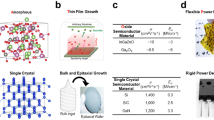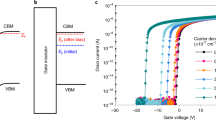Abstract
The continuing drive towards miniaturization of electronic devices1 is motivating the search for new materials. Consider, for example, the case of the much-used dynamic random-access memory. The minimum capacitance per cell that can be tolerated is expected2 to remain at 30–40 fF, but as the cell area decreases, the corresponding reduction in geometric capacitance has to be compensated for. So far, this has been achieved by resorting to complex non-planar structures and/or using much thinner films of the dielectric insulator, amorphous silicon dioxide (a-SiOx), although the latter approach is limited by the electric fields that can be supported by a-SiOx before its insulating properties break down. An alternative strategy is to develop thin-film insulators that have a dielectric constant significantly greater than that of a-SiOx, reducing the size of the fields required for device operation. Here we show that a composition-spread technique allows for the efficient evaluating of materials with both a high dielectric constant and a high breakdown field. We apply this approach to the Zr–Sn–Ti–O system, and we find that compositions close to Zr0.15Sn0.3Ti0.55O2−δ are better thin-film dielectrics than high-quality deposited a-SiOx. Although detailed tests of the performance of these materials have not yet been carried out, our initial results suggest that they are likely to be comparable to the best alternatives (such as (Ba, Sr)TiO3) currently being considered for integrated-circuit capacitors.
This is a preview of subscription content, access via your institution
Access options
Subscribe to this journal
Receive 51 print issues and online access
$199.00 per year
only $3.90 per issue
Buy this article
- Purchase on Springer Link
- Instant access to full article PDF
Prices may be subject to local taxes which are calculated during checkout



Similar content being viewed by others
References
The National Technology Roadmap for Semiconductorspage 123 (Sematech, Austin, (1994)); also http://www.sematech.org/public/roadmap/ntrs94.pdf.
El-Kareh, B., Bronner, G. B. & Schuster, S. E. The evolution of DRAM cell technology. Solid State Technol. 89–101 (May (1997)).
Gerstenberg, D. in Handbook of Thin Film Technology (eds Maissel, L. & Glang, R.) Ch. 19, page 8 (McGraw-Hill, New York, (1970)).
Waser, R., Baiatu, T. & Härdtl, K.-H. DC electrical degradation of perovskite-type titanates: I, ceramics. J. Am. Ceram. Soc. 73, 1645–1653 (1990).
Baiatu, T., Waser, R. & Härdtl, K.-H. DC electrical degradation of perovskite-type titanates: I, Ceramics. J. Am. Ceram. Soc. 73, 1663–1673 (1990).
Kahawara, T., Yamamuka, M., Yuuki, A. & Ono, K. (Ba, Sr)TiO3films prepared by liquid source chemical vapor deposition on Ru electrodes. Jpn. J. Appl. Phys. 35, 4880–4885 (1996).
Park, S. O. et al. Fabrication and electrical characterization of Pt/(Ba, Sr)TiO3/Pt capacitors for ultralarge-scale integrated dynamic random access memory applications. Jpn. J. Appl. Phys. 35, 1548–1552 (1996).
Basceri, C., Streiffer, S. K., Kingon, A. I. & Waser, R. The dielectric response as a function of temperature and film thickness of fiber-textured (Ba, Sr)TiO3thin films grown by chemical vapor deposition. J. Appl. Phys. 82, 2497–2504 (1997).
Xiang, X.-D. et al. Science 268, 1738–1740 (1995).
Sawatzky, E. & Kay, E. Cation deficiencies in RF sputtered gadolinium iron garnet films. IBM J. Res. Dev. 13, 696–702 (1969).
Hanak, J. J. The ‘multi-sample concept’ in materials research: synthesis, compositional analysis and testing of entire multicomponent systems. J. Mater. Sci. 5, 964–971 (1970).
Wolfram, G. & Göbel, H. Existence range, structural and dielectric properties of ZrxTiySnzO4ceramics (x + y + z = 2). Mater. Res. Bull. 16, 1455–1463 (1981).
Iddles, D. M., Bell, A. J. & Moulson, A. J. Relationships between dopants, microstructure and the microwave dielectric properties of ZrO2-TiO2-SnO2ceramics. J. Mater. Sci. 27, 6303–6310 (1992).
Nakagawara, O. et al. Electrical properties of (Zr, Sn)TiO4dielectric thin film prepared by pulsed laser deposition. J. Appl. Phys. 80, 388–392 (1996).
Acknowledgements
We thank H. Huggins for TiN-coated Si substrates; Y.-H. Wong and D. W. Murphy for technical discussions; and R. A. Laudise for enthusiastic support of this project.
Author information
Authors and Affiliations
Rights and permissions
About this article
Cite this article
van Dover, R., Schneemeyer, L. & Fleming, R. Discovery of a useful thin-film dielectric using a composition-spread approach. Nature 392, 162–164 (1998). https://doi.org/10.1038/32381
Received:
Accepted:
Issue Date:
DOI: https://doi.org/10.1038/32381
This article is cited by
-
Combinatorial synthesis for AI-driven materials discovery
Nature Synthesis (2023)
-
Machine learned synthesizability predictions aided by density functional theory
Communications Materials (2022)
-
Magnetization–structure–composition phase diagram mapping in Co-Fe-Ni alloys using diffusion multiples and scanning Hall probe microscopy
Scientific Reports (2022)
-
Large energy storage density performance of epitaxial BCT/BZT heterostructures via interface engineering
Scientific Reports (2019)
-
Analyzing machine learning models to accelerate generation of fundamental materials insights
npj Computational Materials (2019)
Comments
By submitting a comment you agree to abide by our Terms and Community Guidelines. If you find something abusive or that does not comply with our terms or guidelines please flag it as inappropriate.



